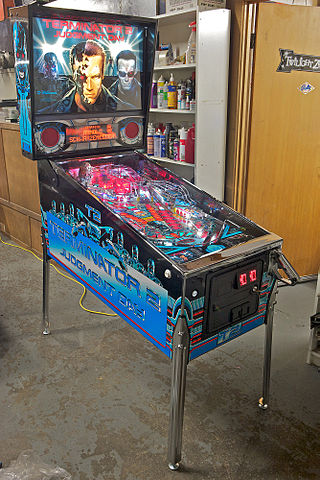
Pinball games are a family of games in which a ball is propelled into a specially designed table where it bounces off various obstacles, scoring points either en route or when it comes to rest. Historically the board was studded with nails called 'pins' and had hollows or pockets which scored points if the ball came to rest in them. Today, pinball is most commonly an arcade game in which the ball is fired into a specially designed cabinet known as a pinball machine, hitting various lights, bumpers, ramps, and other targets depending on its design. The game's object is generally to score as many points as possible by hitting these targets and making various shots with flippers before the ball is lost. Most pinball machines use one ball per turn, and the game ends when the ball(s) from the last turn are lost. The biggest pinball machine manufacturers historically include Bally Manufacturing, Gottlieb, Williams Electronics and Stern Pinball.
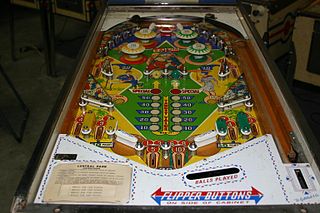
Gottlieb was an American arcade game corporation based in Chicago, Illinois. It is best known for creating a vast line of pinball machines and arcade games throughout much of the 20th century.
A glossary of terms, commonly used in discussing pinball machines.
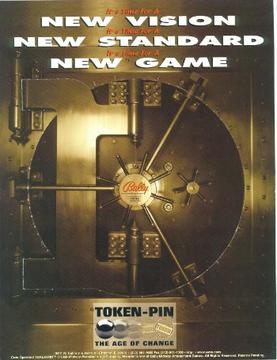
Safe Cracker is a pinball machine with a safecracking theme, designed by Pat Lawlor, and distributed by Midway. It was created in 1996. About 1148 were manufactured.
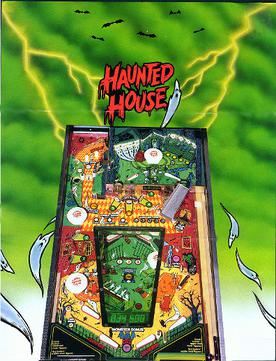
Haunted House is a pinball game released in October 31 1982 by Gottlieb. It was the first game with three playfields that the ball can move between, including one below the main playing surface. Haunted House was designed by John Osborne, with artwork by Terry Doerzaph. It is part of Gottlieb’s “System 80” series of pinball machines.
Batman Forever is a pinball machine released in June 1995 by Sega Pinball. It is based on the motion picture of the same name.

Baffle Ball is a pinball machine created on November 19, 1931, by David Gottlieb, founder of the Gottlieb amusement company.

Central Park is a pinball machine that was released by Gottlieb in 1966. The game was sold in 3,100 units. It was designed by Ed Krynski and the art was done by Roy Parker.

Tee'd Off is a pinball machine designed by Ray Tanzer and Jon Norris and released by Gottlieb in May 1993.
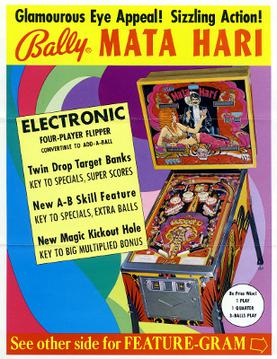
Mata Hari is a pinball machine created by Bally Manufacturing in 1977 and released in 1978. The theme of the game is based on Dutch exotic dancer, Mata Hari. It was mainly produced using solid-state electronics but also 170 electro-mechanical versions were released. It was the last model manufactured by Bally in two such versions. Approximately 20 sample games were produced with a plastic playfield, instead of the traditional wooden playfield.

Harley-Davidson is a Sega Pinball pinball machine released in September 1999 and was the last machine released by this company. It was designed by Jon Borg and Lonnie D. Ropp.

Taito of Brazil was a pinball and arcade manufacturer located in São Paulo, Brazil. The company originally started out as Clover Electronic Amusement in 1968, then became Taito of Brazil in 1972 by Abraham "Abba" Kogan, the son of the founder of the parent company Taito located in Japan. This subsidiary was originally an importer of existing U.S. and Japanese machine components to be assembled within the country. However, the taxation on imports had been growing steadily, and the government's belief that pinball is a game of chance and considered a gambling machine, led to strict import rules. By 1976, within rules created by the Electronic Processing Activities Coordinating Committee (CAPRE), it became illegal to import pinball machines. This created a problem, since the popularity of arcade games in Brazil had been growing exponentially for many years.

Genie is a widebody pinball machine designed by Ed Krynski and released in 1979 by Gottlieb. It features a jinn theme and was advertised with the slogans "Gottlieb's WIDE and Beautiful BODY" and "A Wide-Body Pinball absolutely bulging with player appeal and proven massive profit earning capacity!".

Centaur is a pinball machine designed by Jim Patla and produced by Bally. The game was inspired by the classic Bally's 1956 Balls-A-Poppin that was the first flipper pinball machine with multiball. Because of its success, the pinball machine was re-released in 1983 as Centaur II. The re-release has only a different backbox and was otherwise unchanged.

Flight 2000 is a 1980 Stern widebody pinball machine. It was the first table by this company with speech. The theme of the game revolves around futuristic space flight.

El Dorado City of Gold is a pinball machine designed by Ed Krynski and released in 1984 by Gottlieb. The game features an El Dorado adventure theme.

Lights...Camera...Action! is a pinball machine designed by Jon Norris and released by Gottlieb in 1989. The game features a movie making show business theme.

The Phantom of the Opera is a pinball machine released by Data East in 1990. The game is based on the 1910 French novel The Phantom of the Opera by Gaston Leroux, but not based on the 1986 musical by Andrew Lloyd Webber or movie of the same name, although released around the same time. The game was designed by Joe Kaminkow and Ed Cebula.

Sorcerer is a 1985 pinball machine designed by Mark Ritchie and released by Williams Electronics. The table is placed in the "Internet Pinball Data Base Top 100 Rated Electronic Pinball Machines" chart.
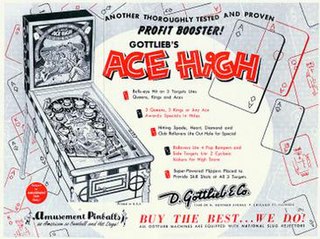
Ace High is a woodrail pinball machine released by Gottlieb in 1957. It features a card gambling theme. It should not be confused with Aces High by Bally.


















